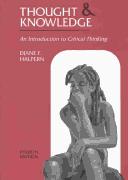Check nearby libraries
Buy this book

When we consider that many of the people alive today will someday be working in jobs that do not yet exist, and that the explosion of information in our world means that today's knowledge will quickly become outdated, two goals for eduction emerge: learning how to learn and how to think critically about information that changes at a rapid rate. Neither education nor business as usual will provide adequately thoughtful perspectives and creative solutions to the problems society faces today.
A genuine commitment to an educated thinking populace will. This book, the third edition of Diane Halpern's best-selling text, was written as tangible evidence of that commitment. In it, the author applies the theories and research of cognitive psychology to the development of critical thinking and learning skills. In addition to its rigorous scholarly grounding, the book is distinguished by its clear writing style, humorous tone, and numerous practical examples and anecdotes.
The book features new and expanded coverage of topics including: analyzing visual arguments; asking questions as a means of understanding complex information; accessing information in problem solving, decision making, and argument analysis; and thinking critically about controversial research. The lessons from this text are brought home in the workbook, Thinking Critically about Critical Thinking, available separately. An instructor's manual is also available from the publisher.
Check nearby libraries
Buy this book

Previews available in: English
Showing 9 featured editions. View all 9 editions?
| Edition | Availability |
|---|---|
|
1
Thought and Knowledge: An Introduction to Critical Thinking
2013, Taylor & Francis Group
in English
1848726295 9781848726291
|
zzzz
Libraries near you:
WorldCat
|
|
2
Thought and Knowledge: An Introduction to Critical Thinking, 5th Edition
2013, Taylor & Francis Group
in English
1848726287 9781848726284
|
zzzz
Libraries near you:
WorldCat
|
|
3
Thought & knowledge: an introduction to critical thinking
2003, Lawrence Erlbaum Associates, Publishers
in English
- 4th ed.
0805839658 9780805839654
|
aaaa
Libraries near you:
WorldCat
|
|
4
Thought and knowledge: an introduction to critical thinking
1996, L. Erlbaum Associates, Brand: Routledge, Routledge
in English
- 3rd ed.
0805814930 9780805814934
|
eeee
|
|
5
Thought and Knowledge: An Introduction to Critical Thinking
November 1995, Lawrence Erlbaum Associates
Paperback
in English
- 3rd edition
0805814949 9780805814941
|
zzzz
Libraries near you:
WorldCat
|
|
6
Thought and Knowledge: An Introduction to Critical Thinking
January 1995, Lawrence Erlbaum Associates
Hardcover
in English
- 3rd edition
0805814930 9780805814934
|
zzzz
Libraries near you:
WorldCat
|
|
7
Thought and knowledge: an introduction to critical thinking
Apr 11, 1989, Lawrence Erlbaum
- 2nd ed.
0805802940 9780805802948
|
eeee
Libraries near you:
WorldCat
|
|
8
Thought and knowledge: an introduction to critical thinking
1989, L. Erlbaum Associates
in English
- 2nd ed.
0805802940 9780805802948
|
zzzz
Libraries near you:
WorldCat
|
|
9
Thought and knowledge: an introduction to critical thinking
1984, L. Erlbaum Associates
in English
0898593816 9780898593815
|
eeee
Libraries near you:
WorldCat
|
Book Details
Table of Contents
Edition Notes
Includes bibliographical references (p. 432-452) and indexes.
Classifications
External Links
The Physical Object
ID Numbers
Community Reviews (0)
Feedback?History
- Created April 1, 2008
- 15 revisions
Wikipedia citation
×CloseCopy and paste this code into your Wikipedia page. Need help?
| November 30, 2023 | Edited by MARC Bot | import existing book |
| November 15, 2023 | Edited by MARC Bot | import existing book |
| December 9, 2022 | Edited by ImportBot | import existing book |
| November 15, 2022 | Edited by ImportBot | import existing book |
| April 1, 2008 | Created by an anonymous user | Imported from Scriblio MARC record |














